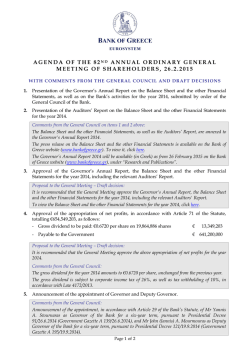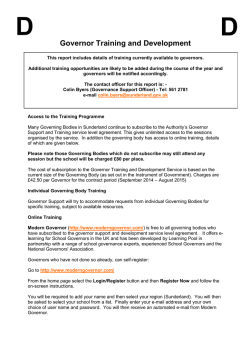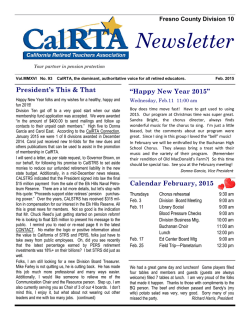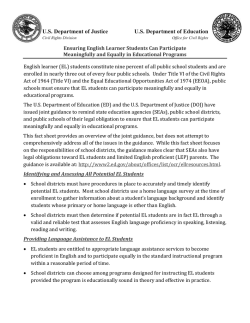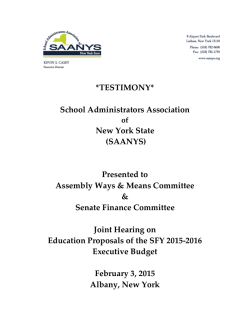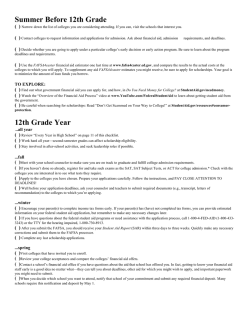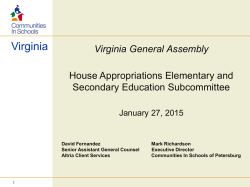
Legislative Report - Southern Regional Education Board
Legislative Report #1 February 2015 Governors’ legislative and budget proposals in Georgia, Mississippi, South Carolina, Virginia and West Virginia Notes from other SREB states Legislative Report Governors’ legislative and budget proposals Georgia (http://opb.georgia.gov/governors-budget-reports) The governor submitted his proposals to the General Assembly to amend 2014-15 appropriations and make budget recommendations for 2015-16. The proposals reflect expected steady revenue growth for the current fiscal year and accelerated growth in 2015-16. The governor’s budget maintains his spending strategies and provides strategic increases in priority areas. As part of his amendments to the current-year budget, the governor requests an additional $1 million to support the Education Reform Commission, created by the governor to study access to early learning programs, to keep high quality teachers in classrooms and expand school options for families. A subset of the commission will examine the state’s Quality Basic Education (QBE) funding formula for K-12 schools. In the governor’s State of the State address, he announced his plan for a constitutional amendment that would establish an Opportunity School District modeled after existing systems in other states and allow the state to take over “failing” public schools. Southern Regional Education Board sreb.org The general fund budget for 2015-16 would increase 5 percent over the enacted 2014-15 budget to $19.2 billion. The K-12 education general fund budget would increase from the original 2014-15 budget 6.9 percent to $8.5 billion in 2015-16, with QBE formula funding up 7 percent to $8.2 billion. This budget includes $280 million to offset a portion of previous austerity reductions, intended to provide flexibility for districts to eliminate furlough days, increase instructional days and increase teacher salaries. The plan recommends an additional $2.4 million in 2014-15 and $1 million in 2015-16 for the newly implemented Georgia Milestones Assessment Program, the testing system aligned to the Common Core Georgia Performance Standards and implemented in the 2014-15 school year. The proposal allocates $2 billion to the University System of Georgia in 2015-16, a 4.1 percent increase. Funding to the technical college system would increase 2.4 percent to $339.8 million. The proposal also would more than double general funds provided for the Accel Dual Enrollment program, to $21.4 million, for 2015-16. In 2015-16, lottery funding for the statewide prekindergarten program would increase 2.2 percent to $321.3 million. Funding for merit-based HOPE Grants to students attending technical schools, including Zell Miller Grants for the highest-performing students, would remain at $109.1 million through 2015-16. The governor proposed increasing the HOPE Grant award amount by 3 percent and increasing the Zell Miller Grant award. HOPE Scholarships for students at public colleges and universities would receive a 3.8 percent increase to $463.4 million. Award amounts for HOPE Scholarships would increase 3 percent to meet projected student financial needs, and Zell Miller scholars would receive an increase in the award amount. Mississippi (http://www.governorbryant.com/) The governor’s proposed state budget for 2015-16 promotes his priorities of fiscal responsibility and tax credits for working families. The proposal supports economic development, growth in the health care sector and targeted increases for education. In his State of the State address, the governor spelled out his priorities, including tax cuts and funding for workforce training. The governor also called on the Legislature to approve the Equal Opportunity for All Students with Special Needs Act, which would provide scholarships for special needs students to attend private schools or obtain tutoring services, curriculum materials and other educational supplies and services. The governor’s plan would provide $6.2 billion in state funds (up 1.7 percent) for government operations, including nearly $5.6 billion in general funds (up 2.2 percent). State funds for elementary and secondary education would rise 2.1 percent to $2.5 billion. Funding formula support for schools would rise 2.5 percent to just under $2.2 billion. The budget would continue the $15 million allocation to help schools and teachers implement the 2013 Third Grade Gate literacy initiative and $2.3 million for dropout prevention efforts under Jobs for Mississippi Graduates. The governor also proposes $3 million for the Mississippi Building Blocks school readiness program and continued funding for scholarships for high-achieving high school graduates who intend to teach. The proposal maintains $6 million for the state’s Teach for America efforts, $1.5 million for the teacher performancebased pay pilot program and $22.6 million for National Board Certification. The proposal includes $665.4 million (up 0.5 percent) for the university system, which includes level funding of $391.7 million for general university support and $40.6 million (up 7.3 percent) for student financial aid. It also includes $2 million for Jackson State University, which has offered health-related degrees for 15 years, to establish a School of Public Health. Community college funding would increase 4.2 percent to $268 million. The governor’s budget would provide $3 million to establish the Mississippi Works Scholarship program for students to obtain skills certifications and academic degrees at community colleges. South Carolina (http://www.governor.sc.gov/ExecutiveOffice/ExecutiveBudget/) The governor organized her recommended budget for 2015-16 around four themes: educational success, social services reform, community safety, and effective and sustainable health care services. The proposal supports her education priorities: transitioning the state superintendent of education position from elected to gubernatorial-appointed; recruiting and retaining teachers in the state’s rural and underserved school districts; simplifying the state mechanism for funding school districts; hiring more reading coaches; increasing support for reading instruction; investing in school technology; and expanding the South Carolina Public Charter School District. 2 Under her proposal, the total general fund budget would increase 3.3 percent over the originally approved 2014-15 budget to nearly $6.9 billion. General funds for universities would rise 3 percent to $356 million, while technical colleges would receive $132.4 million, up 7 percent. General funds for K-12 education would increase 6.1 percent to $2.6 billion; this includes over $2.4 billion in state aid to school districts, up 6.1 percent. To support the governor’s ongoing priority of improved reading instruction and outcomes, state aid would include $39.4 million (up 33.7 percent) to hire additional reading coaches at schools with low performance on statewide reading assessments and $9 million (up 50 percent) to expand the Summer Reading Camps initiative. Available funding under the Education Improvement Act (EIA), generated from an earmarked 1 percent sales tax, is projected to rise 4.5 percent to $676.8 million. The governor wants to direct the increased funding to the Public Charter School District (up 21.1 percent to $68.1 million), student assessment and testing (up 15.4 percent to $31.5 million), purchases of instructional materials (up 34.2 percent to $28.1 million) and teacher professional development (up 72.5 percent to $9.5 million). The governor recommends closing the National Board Certification program to new participants and, as currently participating teachers phase out of the program, redirecting EIA funding to a rural teacher recruitment initiative. For 2015-16, National Board Certification program funding would decline 4.5 percent to $53 million, providing $1.5 million for the rural teacher recruitment initiative. The initiative would include five incentive programs: subsidized college tuition for students from underserved districts who agree to teach at least two years in their home districts; student loan repayment assistance for certain teachers in underserved districts; salary supplements for teachers with less than 10 years of experience who accept teaching positions in rural districts; tuition support for teachers with five to 10 years of experience to obtain graduate degrees; and teacher mentoring in underserved districts. Lottery funds are projected to decline 13.4 percent to $298.9 million. As a result, the executive budget would reduce combined general and lottery funding for statewide merit-based scholarship programs — the LIFE ($130.6 million, down 7.2 percent), HOPE ($7.5 million, down 11.8 percent) and Palmetto Fellows ($29.5 million, down 21.7 percent) scholarships. The budget would, however, provide level lottery funding of $29.3 million to school districts for technology initiatives and $49.1 million for tuition assistance at two-year colleges (up 3.6 percent). The governor also recommends directing an additional $23.4 million in lottery funding in lieu of general funds for need-based tuition grants to students at independent colleges and universities; overall funding for the program would remain level. To support the governor’s goal of simplifying state funding for school districts, the proposal would eliminate lottery funding for the K-5 Reading, Math, Science and Social Studies Program and the Grades 6-8 Reading, Math, Science and Social Studies Program; increased direct general fund aid to school districts would offset these reductions. The state would provide an additional $8.5 million in general funds to aid school districts with the funding stream transition. Virginia (http://dpb.virginia.gov/budget/) Going into the 2015 legislative session, the governor released his recommended amendments to both years of the 2014-16 biennial budget. His plan addresses a previously projected general fund shortfall of $2.4 billion for the biennium, due to slower than expected economic growth and federal budget sequestration. 3 The Legislature bridged $1.5 billion of the budget gap during the regular session in 2014 and approved an additional $882 million reduction during the September 2014 special session through cuts to agency budgets, the use of reserves and other means. The governor’s proposal incorporates these changes and recommends $272 million in additional reductions, while preserving funding to invest in the workforce and build a postrecession economy less dependent on federal spending. The proposal provides $18.1 billion in general funds for 2014-15, down 0.9 percent from the post-special session budget. General funds for direct aid to public education in 2014-15 would decrease 1.7 percent from the approved budget to $5.4 billion, while colleges and universities would receive $1.3 billion, up 1.8 percent. The proposal makes no cuts to K-12 education, and the decreased aid to public education reflects more current estimates of the state’s school-age population than those on which the Legislature based the original budget. The proposal includes $90 million in cuts to higher education over the biennium from the special session, but recommends no further reductions. The state general fund budget would increase 1.6 percent in 2015-16 to $18.4 billion. Aid to public education would increase 2.7 percent to $5.5 billion. For 2015-16, the governor requests $537,000 in general funds on top of the existing $3.9 million in lottery funds for schools to purchase more student breakfasts and $713,000 to help train principals in struggling schools. He is proposing a one-time sale of unclaimed property and plans to use $150,000 of the proceeds toward reducing the unfunded liability in the state’s teacher retirement system. Proceeds from the sale also would provide, in 2015-16, an additional $75 million for school construction costs, $50 million to help finance loans for school construction and $25 million to allow districts to borrow for school construction at belowmarket interest rates. Colleges and universities would receive $1.3 billion in general funds for 2015-16, about the same level as the prior year. Four-year institutions would operate with $966.5 million, a slight increase primarily due to the 12-month cost of the pay raise given for part of 2014-15. Two-year institutions would remain funded at $355.6 million. The State Council of Higher Education for Virginia estimates planned in-state undergraduate tuition increases for 2015-16 averaging 7.4 percent. The governor also proposes $1 million in additional financial assistance for students to pursue industrybased certifications that meet workforce development needs and $2.5 million in new student financial aid funding. West Virginia (http://www.budget.wv.gov/executivebudget/) The governor delivered his 2015 State of the State address, highlighting several accomplishments of his tenure, including reducing taxes, addressing the state’s long-term financial liabilities, improving the state’s business climate and enacting education reforms. He pointed out the greater number of students obtaining certificates and associate degrees and promoted the West Virginia Workforce Planning Council’s My State, My Life initiative, which is designed to help students plan for career paths in the state. The governor will introduce legislation to encourage individuals from nonteaching backgrounds who possess expertise in critical subject areas to join the teaching profession. He also highlighted his recommendation to establish a network that will review current STEM (science, technology, engineering and math) education offerings in the state and help revise and expand those programs. 4 Under the governor’s proposal, the statewide general fund budget for 2015-16 would increase 1.6 percent to $4.3 billion. However, due to projected revenue shortfalls, the state’s Medicaid program would receive most of the budget increase, while most other areas would see targeted reductions. General funds for K-12 education would decline 1 percent to just over $2 billion, including $1.8 billion in state aid to schools (down 2.4 percent). Total general funding to the state Department of Education for programs, other than state aid to schools, would increase 8.3 percent to $157.7 million; however, much of the increase would be from the addition of new funding for the early literacy program established in 2014 ($5.7 million) and school based truancy prevention ($2 million). The department’s performance audits division would receive $1.8 million, up 7.2 percent. General funds for higher education would decline 2.9 percent to $402.9 million. This includes $269.3 million (down 3.9 percent) for state colleges and universities, $65.1 million (down 1.4 percent) for community and technical colleges and $68.6 million (down 0.1 percent) for the Higher Education Policy Commission. Notes from other SREB states Legislatures have convened their 2015 regular sessions in Arkansas, Delaware, Georgia, Kentucky, Maryland, Mississippi, North Carolina, Oklahoma, South Carolina, Tennessee, Texas, Virginia and West Virginia. Alabama and Florida convene in March, and Louisiana convenes in April. Look for updates on legislative sessions in all of these states at SREB.org; upcoming editions of Legislative Report will include information on final actions as states complete their sessions. Governors in Delaware, Florida, Maryland and Oklahoma released their budget proposals; details on these and other governors’ proposals will appear in upcoming editions of Legislative Report. This report was prepared by Jeffrey Grove, SREB research associate ( [email protected]), Sandra Murray, SREB administrative/research assistant ([email protected]) and Gabrielle Whitney, SREB research associate ([email protected]), with assistance from Gale Gaines, vice president, state services ([email protected]). All can be reached at (404) 875-9211. (15S01) 5
© Copyright 2025
